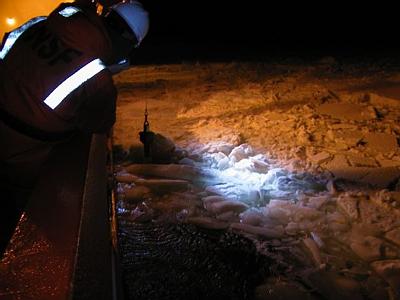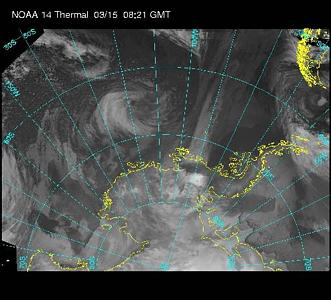15 March, 2000
A Night for King Lear and the Fool
74 11 s, 107 38 w
In front of Thwaites Glacier Tongue
Temp 2 C (28 F)
Wind out of east-northeast 45 knots (52 mph) gusting to 55 knots (63 mph)
Barometer 970 mb, dropping
Intermittent heavy snow falling
It is another horizontal snow night. We're in heavy pack, almost
100% coverage. The wind is howling out of the east and northeast, and we
are struggling through a big mass of floe ice that has been pushed over
against the fast ice northwest of Thwaites Glacier tongue. I can tell when
I wake that Captain Joe is at the controls because the diesels are singing
a higher note than usual. He uses the Nathaniel B. Palmer to the fullest of
its capabilities.
The cause of this ice jam is a storm several hundred kilometers in
diameter centered several hundred kilometers offshore. You can see it on
the National Oceanic and Atmospheric Administration (NOAA) image with this
journal entry. It certainly looks harmless enough in this "thermal" (does
that mean infrared?) image. Notice that the circulation is clockwise around
the low pressure area at the center, because this is the southern
hemisphere. Also notice part of another storm visible in the Drake Passage,
between the Antarctic Peninsula and the southern tip of South America.
We've been trying to lower the CTD to get data from close to the
glacier tongue, but the fast moving ice threatens the thin cable. One
large block could part the wire, sending an expensive instrument to the
bottom of the Amundsen Sea, never to be seen again. We would very much like
to get a good Kasten core here, also. The Captain has tried several places.
He is trying to open and maintain a hole by use of the ship's engines and
thrusters, but has been unable to maintain a clear space long enough to
lower and retrieve the device safely. Finally he decides to move north and
east somewhat, to escape the worst jammed ice.
Five kilometers northeast things aren't quite as bad, and the CTD
goes down into the cold water. The bridge, the Baltic room and the dry lab
are in constant communication, trying to get the data needed with minimal
risk of loss. At one point a floe four meters across drifts alongside the
ship and catches the cable momentarily. When the cable releases it snaps
back and forth like some huge violin string.
On Sara Searson's computer screen the temperature line shows warmer water
deep underneath us, an extension of the Circumpolar Deep Water. If what Tom
Kellogg thinks is correct, this relatively warm water has a lot to do with
"basal melting", or melting of the bottom of the Thwaites and Pine Island
Glaciers.
After the CTD comes up, it's our turn to try getting a Kasten
core. Out on deck the wind noise, combined with that of the winch
machinery, makes conversation difficult. The snow finds little cracks in
our clothing unless we hide behind something. A moving jumble of ice
surrounds the ship. We lower the corer into the water, and retreat inside.
In this depth, more than one kilometer, it takes over a half-hour for the
corer to get to the bottom and return. I take the opportunity to fiddle a
tune or two, to bring us luck in filling the core box.
When the core comes back, we've got good recovery, the first of
three good cores for the night (and of course it had nothing to do with the
fiddle (probably.))
The weather tonight is a precursor of what is to come in the long
Antarctic winter ahead. In July, when I am mowing hay on long hot Maine
days, this part of the world will be just as dark, and colder and windier
than it is now. The Nathaniel B. Palmer will still be working near
Antarctica. Working in severe conditions isn't done by choice or for the
thrill of it. It's just the way the climate is here, and if you want to do
research, you have to work in a certain amount of poor weather. We
certainly have the best of equipment and the ship to do the job safely and
efficiently.
If you have seen Shakespeare's play King Lear, you may remember
the scene when Lear, abandoned by everyone except his jester, wanders at
night in the storm on the moors. It is that sort of night here tonight.
I got a good look at a large Leopard Seal yesterday. The seal
people are especially anxious to sample Leopards, because they are more
rare than Crabeaters or Weddells, and proportionately less is known about
them. The Nathaniel B. Palmer stopped next to the small floe where the seal
was hauled out.
The famous explorer Shackleton at one point described Leopard
Seals as having "horrible reptilian heads" and I think that's an apt
description. Their heads are more blocky than other seals. Their mouths are
much larger, and turn up in the corners to give a freakish smile effect.
The way they move their heads back and forth resembles a turtle or a snake.
I haven't seen a baby Leopard Seal. They must be cute and appealing to
human eyes, but I would not describe the adults as cute.
Thanks to Lois Breger, a librarian in South Carolina, I have the
definitive answer to the penguin knee question. The answer is yes, penguins
do have knees, and kneecaps also. Lois pointed out that there is a book by
a David Feldman called Do Penguins Have Knees? I'll have to find it when I
return to school.
With yesterday's and today's journal entries I've included photos
taken from one of the Nathaniel B. Palmer's two Zodiac inflatable boats.
Since we were not coring yesterday morning, I had a chance to go out with
the ice people to do their morning satellite pass observations. It was a
cold morning for cruising around in an open boat, but it was nice to see
the ship from a distance. Since we were stopped anyhow, the seal people
took advantage of the chance to get DNA samples from some nearby Crabeater
seals. They came along with us, and we left them on the pack ice, to be
picked up on our return. We continued until we were a kilometer away from
the ship. Steve Ager nosed the boat onto some new ice and stopped the
motor. I collected some sea ice, slush, and seawater samples for oxygen
isotope analysis by Doug Introne, my roommate. While I was doing this, Dr.
Shusun Li and Xiobang Zhou worked on their observations. I haven't yet
found the time to ask them for a full explanation of what they are doing,
but I have it in mind.

The Kasten corer comes up through the ice just north of Thwaites Glacier Tongue. I fiddled it down and fiddled it up, and it brought up over a meter of core.

King Lear's storm. It doesn't look like a whole lot here, just a clockwise swirl of clouds. There is another one on the right, between the Antarctic peninsula and Cape Horn. Thwaites Glacier and Pine Island Bay are at the center of this NOAA image.

High overhead a satellite passes as Xiaobing Zhou (visible) and Shusun Li (under blanket) take optical measurements. Shusun is hiding under the blanket so that he can see the screen of a laptop computer he is using to record data. I still don't know exactly what they are measuring, except that they want to compare their measurements to those of the satellite. The Zodiac can go through young gray ice a couple of inches thick; we're stopped on some now.
Contact the TEA in the field at
.
If you cannot connect through your browser, copy the
TEA's e-mail address in the "To:" line of
your favorite e-mail package.
|
